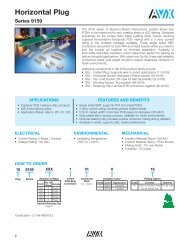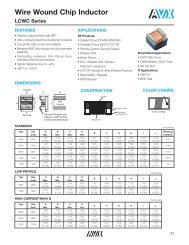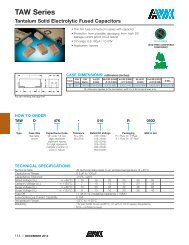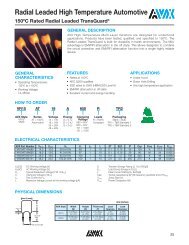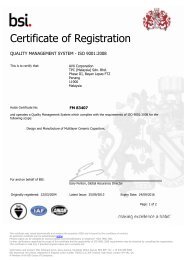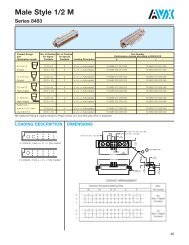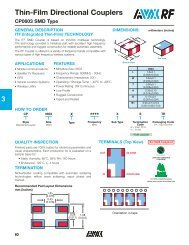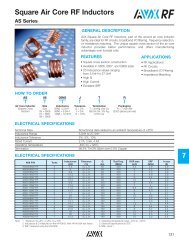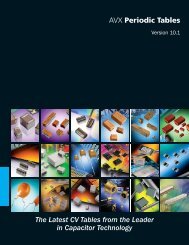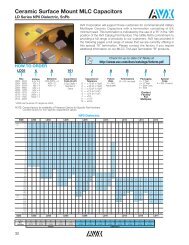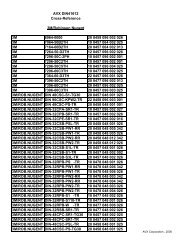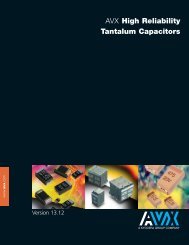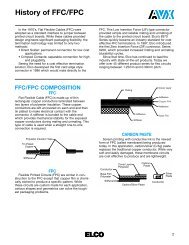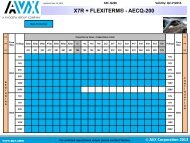X5R Dielectric LD Series Tin/Lead Terminations - AVX
X5R Dielectric LD Series Tin/Lead Terminations - AVX
X5R Dielectric LD Series Tin/Lead Terminations - AVX
Create successful ePaper yourself
Turn your PDF publications into a flip-book with our unique Google optimized e-Paper software.
High Voltage Ceramic Capacitors<br />
Type HP/HW<br />
Type HD/HE<br />
SELECTION GUIDE<br />
Main Signal Application <strong>Series</strong> Type Size Finish<br />
Component<br />
Pulses High Energy Molded discs HP 30 Epoxy<br />
AC or DC Pulses with 40 potted<br />
or AC connections 50<br />
or DC 60<br />
Uncoated HW 30 Uncoated<br />
discs with 40<br />
connections 50<br />
60<br />
AC AC Voltage Molded discs HD 30 Epoxy<br />
dividers at with 40 potted<br />
line frequency connectors 60<br />
Uncoated HE 30 Uncoated<br />
discs with 40<br />
connectors 60<br />
GENERAL CHARACTERISTICS<br />
HIGH VOLTAGE / AC USES<br />
• The main applications include live line indicators, AC dividers,<br />
grading systems for power distribution network, protection for<br />
HV switches and power circuit breakers. Coupling, by-passing<br />
high frequency circuits also use HV ceramic disc capacitors.<br />
• These applications require:<br />
- a high internal resistance.<br />
- a high dielectric strength.<br />
- low or moderate losses at working frequencies (from 50<br />
Hz up to 10 kHz).<br />
The active power (or losses) being:<br />
Wa = 2ΠFC tg δ V 2 = k (Ctg δ) (FV 2 )<br />
This shows that improved performances are obtained<br />
when:<br />
- Good dielectric properties (low tg δ) and<br />
- No long term overvoltage are present and<br />
- Capacitors free of “partial discharge” (corona) effect,<br />
up to rated rms voltage.<br />
TPC is able to perform “discharge free test” and may<br />
guarantee a rate as low as 5 picocoulombs at V rms upon<br />
request.<br />
• High voltage capacitors for AC uses are mainly made of type<br />
II dielectrics. Most of these materials except strontium titanate<br />
exhibit a significant non-linearity. Consequently, the capacitance<br />
value depends on the voltage across the component<br />
and on the frequency of the applied signal.<br />
Not RoHS Compliant<br />
Check for up-to-date CV Tables at<br />
http://www.avx.com/docs/catalogs/hp-hw-hk.pdf<br />
HIGH ENERGY PULSES<br />
• Laser pulses circuitry, high energy/high voltage test equipment<br />
(HV accelerators, physics research) require products<br />
especially adapted to their specific requirements.<br />
• Because of the high energy involved, the design of the capacitors<br />
have to provide:<br />
- a very low ESR (equivalent series resistance) to mini-mize<br />
the lossed energy.<br />
W = ∫ ip (ESR 2 ) di<br />
- a very low ESL (equivalent series inductance) to keep the<br />
correct pulse shape.<br />
Typically due to the design of the electrodes, the products<br />
exhibit:<br />
- ESR: ~ 10 mΩ<br />
- ESL: < 30 nH<br />
- peak current up to 50 kA<br />
- a high withstanding of very large dV or short signal rise<br />
time.<br />
- a high energy density J<br />
J = 1 2<br />
k ε o ε r E 2 (with E = V/m)<br />
even under high electric field, (implying that ε r is very little<br />
voltage dependent).<br />
Through the use of almost linear or non-voltage dependent<br />
capacitors, the stored energy can reach 50 to 100<br />
J/liter for the HP/HW products.<br />
• To ensure these properties, traditional ferroelectric type II<br />
capacitors cannot be used due to their electrostrictive and<br />
piezoelectric properties. The capacitors use quasi “paraelectric”,<br />
strontium-based, ceramic material.<br />
• The main applications are coupling, decoupling, multipliers<br />
circuits, HV DC power supplies, high voltage dividers.<br />
dt<br />
146 | www.avx.com



